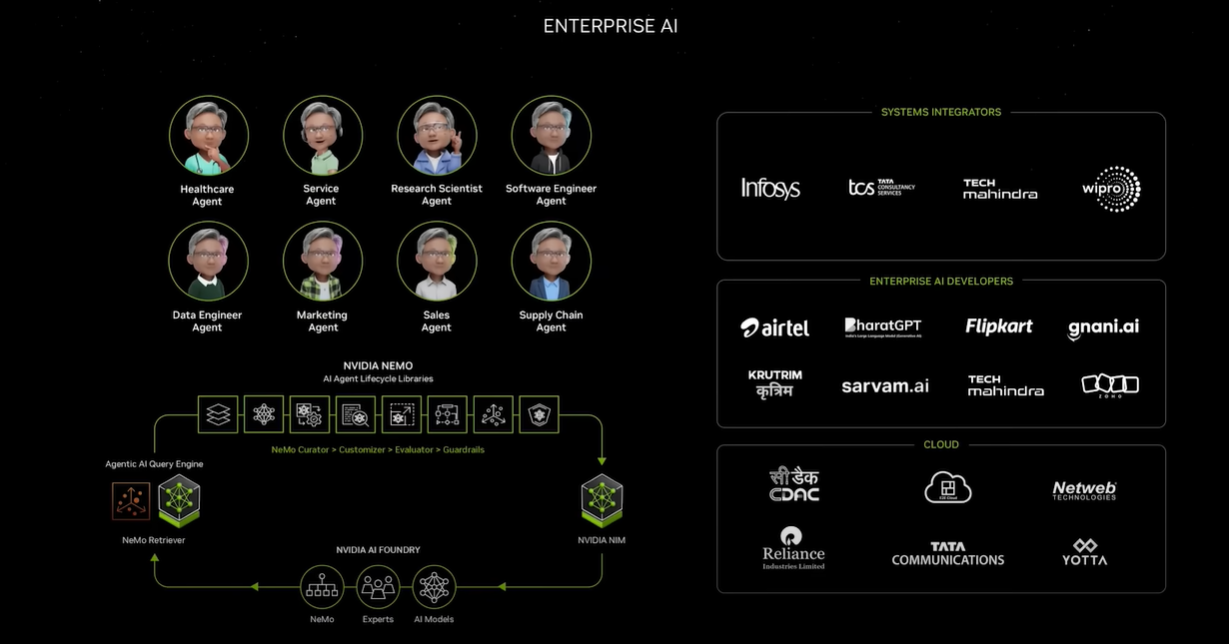
The Future of AI: Insights from NVIDIA’s CEO Jensen Wang
NVIDIA’s CEO Jensen Wang recently delivered a thought-provoking address at an AI Summit in India. His talk focused on three pivotal topics that are shaping the future of artificial intelligence: inference time, the rise of AI agents, and the transformative potential of physical AI with humanoid robots. Let’s delve deeper into these key insights and their implications for the world of AI.
Understanding Inference Time in AI
One of the most intriguing aspects of Jensen’s address was his discussion on inference time in AI systems. He compared this new paradigm to the concepts of ‘System One’ and ‘System Two’ thinking. System One represents quick, instinctive responses, while System Two involves more deliberative thought processes.
This distinction is crucial as AI continues to evolve. The new generation of AI models, such as NVIDIA’s, are designed to take their time to process information, leading to more accurate and thoughtful responses. For example, if you were asked about your favourite Indian food, you could quickly answer ‘chicken biryani’ without much thought. However, a complex question like planning a multi-city trip requires deeper reasoning and computation.
Jensen emphasized that the scaling laws governing AI development are shifting. The longer an AI model thinks during inference, the higher the quality of its output. This insight is not just logical; it’s intuitive. The ability to compute and reason will enhance the AI’s capability to provide nuanced answers, especially for complex tasks.

Photo by Nick Fewings on Unsplash
As we move towards 2025, this approach to inference time will redefine how AI interacts with users and processes data. High-quality responses will become the norm as AI systems are designed to think more like humans, engaging in deeper reasoning.
The Rise of Autonomous AI Agents
Another significant topic discussed was the emergence of autonomous AI agents. Jensen predicted that 2025 would be a landmark year for AI agents in the workplace. These agents will perform various tasks, enhancing productivity and efficiency across numerous sectors.
He introduced two crucial platforms that will facilitate this shift: NVIDIA AI Enterprise and NVIDIA Omniverse. NVIDIA AI Enterprise is designed to harness the capabilities of large language models, allowing for the creation of agents that can understand and process diverse data types, including video, audio, and text.
These agents will operate in a structured manner, perceiving their environment, reasoning through tasks, and connecting with other AI models to complete complex objectives. For instance, a marketing agent may analyze data to develop targeted campaigns, while a customer service agent can interact with clients more effectively.

Photo by ZHENYU LUO on Unsplash
The integration of these agents into businesses will be akin to onboarding new employees. Companies will train these AI agents, ensuring they understand the organization’s specific needs and vocabulary. This approach will lead to the development of supercharged employees, where AI acts as an augmentation tool.
Physical AI: The Next Frontier
Jensen’s address also highlighted the exciting potential of physical AI, particularly through the use of humanoid robots. As AI agents become more prevalent, the question arises: how can we translate this digital intelligence into the physical world?
To tackle this challenge, NVIDIA has developed three essential computing systems: the DGX for training AI models, Omniverse for simulating physical environments, and Jetson AGX for deploying these models in real-world robotic systems. This triad of technology is crucial for creating physical AI capable of interacting with and manipulating the physical world.
Jensen described Omniverse as a virtual world that adheres to the laws of physics, enabling robots to learn and practice their skills. This platform allows for the creation of digital twins—virtual replicas of physical systems—where robots can be trained before being deployed in real-world scenarios. This process not only enhances safety but also reduces risks and costs associated with physical deployments.

Photo by Robo Wunderkind on Unsplash
The implications of physical AI are vast. Industries such as manufacturing, logistics, and healthcare stand to benefit significantly from the deployment of humanoid robots and autonomous systems. These robots will be able to perform complex tasks, collaborate with humans, and optimize operations in ways that were previously unimaginable.
Conclusion: A Transformative Era Ahead
Jensen Wang’s address at the AI Summit provided a glimpse into the future of artificial intelligence. As we approach 2025, the integration of enhanced inference capabilities, the rise of autonomous AI agents, and the development of physical AI will redefine how we interact with technology.
These advancements promise not only to enhance productivity but also to transform industries fundamentally. The AI landscape is rapidly evolving, and NVIDIA is at the forefront of these innovations, paving the way for a future where AI and humans work collaboratively to solve complex challenges.
For those interested in staying ahead of the curve in AI technology, consider exploring more about NVIDIA’s initiatives and how they can be applied within your own organization.
To learn more about the latest developments in AI, visit the TheaiGrid – The Latest AI News and updates and stay updated on groundbreaking advancements.



